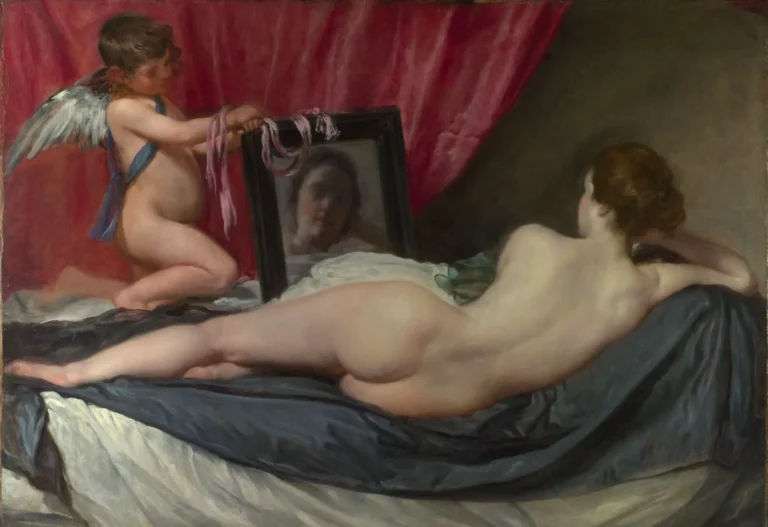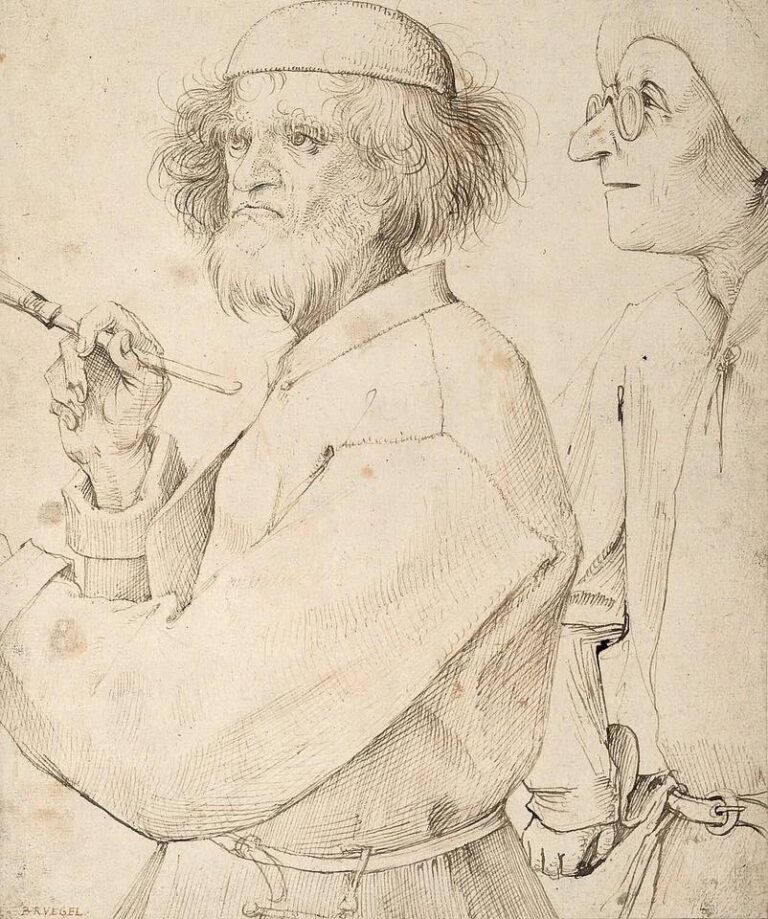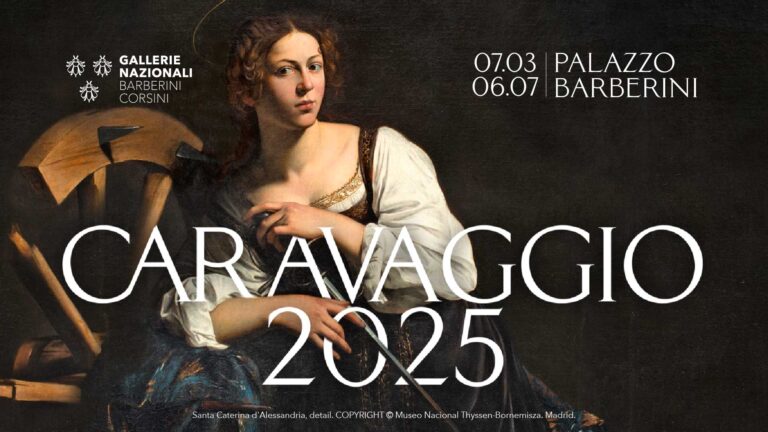Looking for a muse? Check no further. Discover the Best of Art, Culture, History & Beyond!
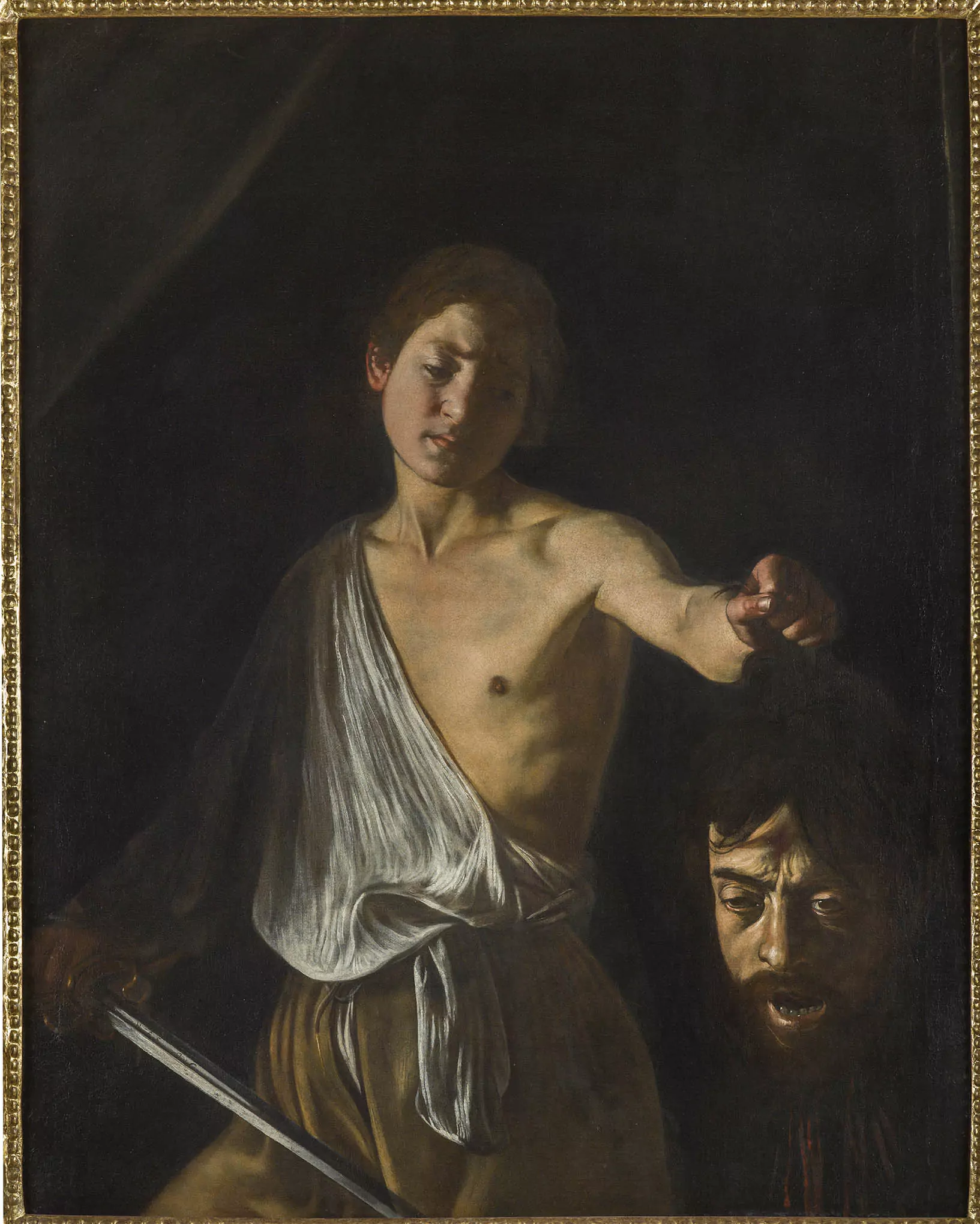
David with the Head of Goliath is, according to art historians, a self-portrait of Caravaggio. Some argue that both figures are representative of Caravaggio, with the young figure of David representing young Caravaggio, and the detached and bloody head of Goliath represents Caravaggio as a man.
Artist : Michelangelo Merisi da Caravaggio (29 September 1571 – 18 July 1610)
Title : David with the Head of Goliath
Date : 1606-07 or 1609-1610
Medium : oil on canvas , Dimensions : 125×101 cm
Location : Galleria Borghese, Rome
The painting depicts a young David, his chest partially exposed as if his shepherd’s tunic had slipped during the intensity of battle. In his left hand, he firmly grasps the severed head of Goliath by the hair. Goliath’s mouth is slightly ajar, as if frozen mid-scream at the moment of death. His lifeless eyes, half-lidded, stare blankly into the void, while blood drips grotesquely from his detached head.
As David holds the head, his gaze is lowered, wearing an expression that has sparked much debate. Some interpret his look as reflective, even sorrowful, suggesting a sense of compassion or regret. Others perceive a quiet victory in his demeanor, with his illuminated face standing in stark contrast to the dark, shadowy background.
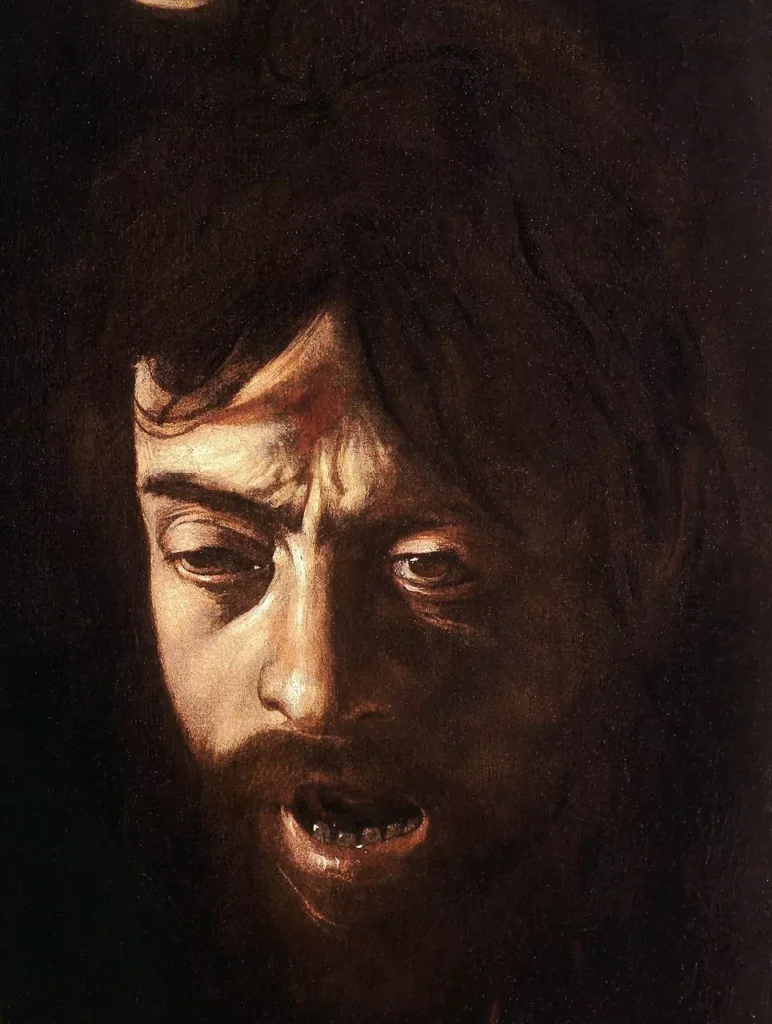
Instead of the iconic sling from the biblical tale, David wields Goliath’s own sword—the very weapon he used to strike him down. Inscribed on the blade is “H-AS OS,” believed to stand for the Latin phrase Humilitas occidit superbiam (“humility shall kill pride”). The painting remains housed in the Galleria Borghese in Rome, where Caravaggio sent it as a desperate plea for papal pardon. Although the Pope did grant clemency, Caravaggio tragically succumbed to illness before the news could reach him.
Commentary from the Borghese Gallery:
This painting has always been the focus of critical debate over both its dating and the various ways in which it can be interpreted. Undoubtedly the work expresses the human drama experienced by the Lombard artist, who was forced to flee Rome in 1606 in the wake of murder allegations. He took refuge first in Paliano and then in Naples under the protection of the powerful noble family of the Colonna.
The choice of subject – David’s victory over the giant Goliath – was most likely made by the artist himself. Indeed the hero of Israel does not gesture triumphantly but rather seems sad, melancholy and moved as he observes the severed head of the terrible Philistine, whose face represents Caravaggio’s own self-portrait. Painted against a dark background, the young shepherd – symbol of victorious virtue and courage – grips a sword whose blade bears the abbreviation ‘H.AS O S’, which first Maurizio Marini (1987) and then Sergio Rossi (1989) and Maurizio Calvesi (1990) deciphered as meaning ‘H[umilit]AS O[ccidit] S[uperbiam]’ (‘humility kills pride’). This interpretation contrasts with that suggested earlier by Wagner (1958), who read the letters as the indicating the artists signature (‘M. A. C. O.’: ‘M[ichaeli] A[ngeli] C[aravaggio] O[pus]’), as well as with that of MacRae (1964), who argued that the markings were no more than the brand of the sword faithfully reproduced by Merisi.
In any case, we know with certainty that the canvas reached Rome by 1613, when it was documented in the cardinal-nephew’s collection (Della Pergola 1959): Scipione Borghese in fact issued a payment to the cabinet maker Annibale Durante for the construction of several frames, one of which for the ‘painting of David with the head of Goliath’, whose dimensions – ‘5 palms high by 4’ – roughly correspond to those of the work in question. In that same year, Scipione Francucci saw the painting at the Casino di Porta Pinciana (Francucci 1613). It was also described in 1650 in the same location by Iacomo Manilli, who was the first to point out that Caravaggio ‘wished to portray himself’ in the face of the giant and ‘his Caravaggino’ in that of David: critics have variously interpreted the latter name to refer to the painters Tommaso Donini, Mao Salini and Cecco del Caravaggio (see in this regard Della Pergola 1959; Marini 1987; Papi 1992; Coliva 2004; Papi 2010). Manilli’s attribution of the work to Merisi has been universally accepted, from the historic Borghese inventories (Inv. 1693; Inv. 1790) to 18th-century guidebooks, from the 1833 Inventario Fidecommissario to Giovanni Piancastelli (1891), and from Adolfo Venturi’s Catalogo (1893) to all subsequent critics.
On the basis of Giovan Pietro Bellori’s claim (1672) that Scipione directly commissioned the work to Caravaggio, a number of critics have dated its execution to 1605-06 (Pevsner 1927-1928; L. Venturi 1921; Della Pergola 1959; Jullian 1961; Ottino della Chiesa 1967; Christiansen 1990), in other words to the last months of his stay in Rome (see Mahon 1952); according to this chronology, he executed the work immediately after the Madonna and Child with Saint Anne (Galleria Borghese, inv. no. 110) and just before the Saint John the Baptist (Galleria Borghese, inv. no. 267). After initially accepting this date (1951; Id. 1952), Roberto Longhi first moved it back to the end of the artist’s Roman period (1957) and then even further to the beginning of his second stay in Naples, namely between September and October 1609 (1959; 1968), noting certain compositional and stylistic similarities with the Salomè of the National Gallery of London. While most critics agreed with Longhi (Marini 1971; Hibbard 1983; Pacelli 1994), some dissented: Raffaello Causa (1966) dated the work to Merisi’s Neapolitan-Sicilian period, Alfred Moir to either 1607 or 1609-10 (1976; 1982), and Vincenzo Pacelli (1977; 1978) to his first stay in Naples, a date he later pushed back to the artist’s second stay (1994).
Maurizio Calvesi (1985) was the first scholar to propose that Caravaggio painted the Borghese canvas as a pledge to obtain the pope’s pardon for the murder of Ranuccio Tomassoni. Assuming that the work was executed at the end of 1609, this critic wrote of a gift to be delivered to Paul V by his nephew Scipione Borghese, a painting which depicted the artist’s decapitation. According to this hypothesis, the subject mirrors the psyche of the painter, who is here portrayed twice, in the guise of both the victim and the executioner (Rossi 1989). A conflict was thus given expression between his superego – David, representing the morality that metes out punishment – and his ego – the sinner Goliath who asks for punishment (Röttgen 1974). This reading, which still represents the most widely accepted interpretation, contrasts with other opinions (see Cinotti 1983 for a full discussion), including the homoerotic interpretation offered by Christoph Luitpold Frommel (1971).
In addition, critics have noted that the same model used for the Borghese Saint John the Baptist is recognisable in the figure of David (Cinotti 1983; Papi 1992). According to Marini (1987), this young man hailed from the same town of Caravaggio in Lombardy and was close to the painter, whom he met in the alleyways of Naples. The motif of David’s extended arm reflects that found in the Apoxyomenos and, incidentally, in the executioner of the London Salomè: Marini (1974; 1987) read it as a antiheroic gesture full of psychological and emotional import; he further traced the scene to a passage in 1 Samuel (17:57): ‘And as David returned from the slaughter of the Philistine, Abner took him, and brought him before Saul with the head of the Philistine in his hand’. The work in fact depicts the precise moment when David, standing at the entrance of Saul’s tent – which can be glimpsed in the upper left hand corner – shows his horrible trophy. In 1983, finally, Howard Hibbard took up an interpretation originally proposed by Calvesi (1971), relating the figure of David to that of Christ: traditionally proposed by the Bible, this comparison was emphasised by Augustine, to whom the abbreviation on the cold blade of the sword refers.
While the subject remains open to different interpretations, today most critics (most recently Terzaghi 2019) are certain that the canvas was produced during the artist’s second stay in Naples. This seems to be confirmed by – among other details – the application of the colour, the treatment of the light and the reduction of the chromatic range, characteristics found in other works of this period, in particular The Martyrdom of Saint Ursula in Palazzo Zevallos in Naples (see Coliva 2010). In this regard, however, the present writer feels that it is necessary to keep open the question of the date of its execution, especially in light of two further considerations. First of all, its conservational state – the painted surface has become thin and eroded because of numerous restoration operations – has led some scholars to postdate its execution to a later period. Secondly, diagnostic testing (Cardinali 2016; De Ruggieri 2016) has revealed the presence of several incisions in the canvas as well as a preparatory phase similar to that of works painted by Merisi in 1606-07. These elements may indicate a dating between the end of his Roman period and the first months of his stay in Naples. This chronology has indeed been upheld by a number of critics, including Keith Christiansen (1990), Gianni Papi (1991; 1992; 1996; 1997; 2001; 2005), Francesca Cappelletti (2009) and Sybille Ebert-Schifferer (2009). Moving the execution of the work back to 1606-07 would not exclude the hypothesis that Caravaggio intended the work as a means of seeking pardon, alluded to by the severed head of the giant (capital punishment had been implemented in 1606, as the painter was by then aware). It would further explain that plastic rendering of volumes – compact and vital – closer to his late Roman works rather than to those of his last years, which are characterised by a more rapid, summary execution.
What today seems beyond doubt is that the canvas was in Naples in 1610, as suggested by documents recording the commission for two copies of Caravaggio’s David (Pacelli 2002) made by Viceroy Pedro Fernández de Castro, Count of Lemos, to the painter Baldassarre Alvise, whom critics have identified as the Bolognese artist Baldassarre Aloise, called Galanino (Coliva 2004; Terzaghi 2010). During his stay in Naples, where the original was evidently present, this painter executed a David, which is most likely a copy of the Borghese canvas: indeed, most critics – most recently Vodret (2021) – believe that the Borghese work served Alvise as the prototype. With regard to its arrival in the Eternal City, finally, scholars have not excluded the possibility that the painting formed part of the luggage with which Caravaggio boarded the boat which left Naples in July 1610 destined to Rome. As letters of Diodato Gentile, Bishop of Caserta, indicate, it indeed seems that on that occasion the painter took several paintings with him. As is known, Caravaggio became separated from these during the crossing from Naples to Palo Laziale, where the artist was forced to interrupt his journey, in circumstances that have not been completely clarified. Shortly thereafter, he met his miserable, premature death on a warm summer’s day on a torrid beach of Porto Ercole.
At present seven copies of the canvas are known, of which five are held in private collections (see Marini 1974; Moir 1976; Pacelli 1977) and one each at the Museu Historico of Bahia in Brazil (see Marini 1974) and the Gemäldegalerie in Kassel (see Moir 1976).

This article is published on ArtAddict Galleria, where we explore the intersections of art, history, and culture. Stay tuned for more insights and discoveries!
